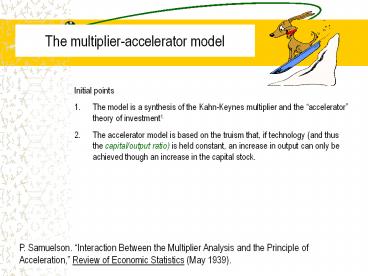The multiplier-accelerator model - PowerPoint PPT Presentation
Title:
The multiplier-accelerator model
Description:
If B = 1 (and presuming that A2 4B), then cycles are constant in amplitude. ... The time lag between a change in output and a change in (net) investment can be ... – PowerPoint PPT presentation
Number of Views:672
Avg rating:3.0/5.0
Title: The multiplier-accelerator model
1
The multiplier-accelerator model
- Initial points
- The model is a synthesis of the Kahn-Keynes
multiplier and the accelerator theory of
investment1. - The accelerator model is based on the truism
that, if technology (and thus the capital/output
ratio) is held constant, an increase in output
can only be achieved though an increase in the
capital stock.
P. Samuelson. Interaction Between the Multiplier
Analysis and the Principle of Acceleration,
Review of Economic Statistics (May 1939).
2
The accelerator
- Firms need a given quantity of capital to produce
the current level of output. If the level of
output changes, they will need more capital. How
much more? - Change in capital accelerator ? change in
output (10.1) - But firms can only increase their capital stock
by (positive) net investment. How much? - Net investment accelerator ? change in output
(10.2) - It is also true that
- Accelerator Change in Capital/Change in Output
3
Capital/Output ratio
- If we do not allow for productivity boosting
technical change, then the capital output ratio
is held constant. - If fact, this is what we are assumingno
technical change.
4
Example of the accelerator principle
- We assume that ? 3a . That is, it takes 3
dollars worth of capital to manufacture 1 worth
of shoes. - Hence if the demand for shoes increased by say,
10, there would be a need for 30 in additional
capitalor equivalently, 30 in net investment.
aSherman Kolk claim this is a reasonable figure
since estimates show that GDP is typically equal
to 1/3 the value of the capital stock.
5
Time period Demand for Shoes Change in Demand for Shoes Shoe Machinery Change in Shoe Machinery
1 100 300
1 to 2 10 30
2 110 330
2 to 3 20 60
3 130 390
3 to 4 5 15
4 135 405
4 to 5 0 0
5 135 405
5 to 6 -5 -15
6 130 390
6
Formalizing the model
If the economy is in equilibrium, Then output
supplied (Y) is equal to aggregate demand (AD).
Assuming a closed economy without government, we
have
Yt Ct It
(1)
7
Formalizing the model
- The consumption function is given by1
(2)
- We assume that investment in the current period
(It) is equal to some fraction (?) of change in
output in the previous period (or lagged output)
(3)
1 We assume that C depends on lagged, rather than
current, income. Also note that for our
simplified economy, Y YD.
8
Insert (2) and (3) into (1) to obtain
(4)
To get a homogenous equation, we ignore the
constant
To get a standardized form, let A c ?. Also,
Let B ?. Thus we can write
(5)
Note for the mathematically inclined equation
(5) is a 2nd order (homogenous) difference
equation.
9
It can be shown that
- There will be cyclical fluctuations in the time
path of national income (Yt) if A2 lt 4B. - If B 1 (and presuming that A2 lt 4B), then
cycles are constant in amplitude. - If B lt 1 (and presuming that A2 lt 4B), then
cycles are dampedthat is, amplitude is a
decreasing function of time. - If B gt 1 (and presuming that A2 lt 4B), then
cycles are explosivethat is, amplitude is a
increasing function of time. - There will be no cyclical fluctuations if A2 gt 4B.
10
Example of the Multiplier-Accelerator
Assumptions (1) Y is 996 in period 1 and 1000
in period 2 (2) C 96 .9Yt - 1 and (3) ?
1
11
Assumptions (1) Y is 996 in period 1 and 1000
in period 2 (2) C 996 .9Yt -- 1 and (3) ?
B 1
12
Damped oscillations
B lt 1 and A2 gt 4B
National Income
Time period
13
Explosive oscillations
B gt 1 and A2 gt 4B
National Income
Time period
14
Qualifications/limitations
- This model is based on a crude theory of
investment. There is no role for expected
profits or animal spirits. - The time lag between a change in output and a
change in (net) investment can be significantthe
investment process (planning, finance,
procurement, manufacturing, installation,
training) is often lengthy. - J. Hicks pointed out that, for the economy as a
whole, there is a limit to disinvestment
(negative net investment). At the aggregate
level, the limit to capital reduction in a given
period is the wear and tear due to depreciation.































